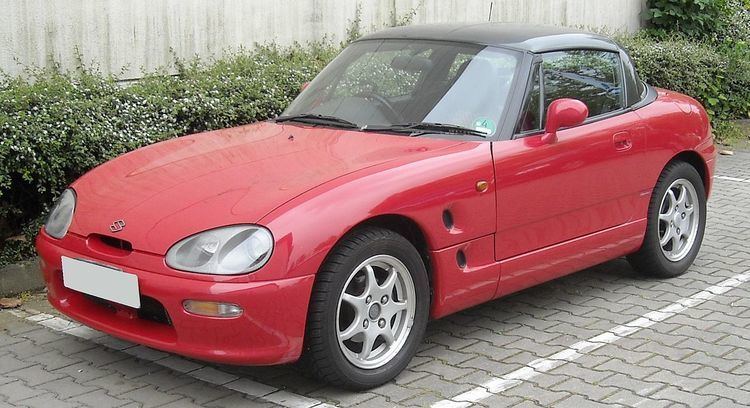Layout FMR layout | Production 1991–1997 Body style 2-door roadster Engine 657 cc (0.7 L) DOHC I3 | |
 | ||
The Suzuki Cappuccino is a small 2-door, 2-seater detachable hardtop minicar produced by Suzuki Motor Corporation. The vehicle was designed to meet Kei car specifications for lower tax and insurance in Japan. Weighing 725 kg (1,598 lb), the Cappuccino is powered by a turbocharged, three-cylinder, 657 cc DOHC engine (just under the 660cc maximum displacement allowed for a Kei car). Its dimensions also conformed to Kei car regulations on length and width, being 3,295 mm (129.7 in) long and 1,395 mm (54.9 in) wide.
Contents
Front-rear weight distribution is claimed to be 50/50% when both seats are occupied. Layout is front mid-engined and rear-wheel drive. The hood, roof, roll bar and lower front guard panels are aluminium.
Three removable roof panels mean that the car can be used as a closed coupé; T-top; targa; or, on retraction of the rear window and roll bar, a full convertible. Roof panels stow in the trunk (taking almost all the luggage space), and the rear window/rollcage assembly retracts into the body behind the seats. Unlike many convertibles of the time, the rear window is glass and wraparound, with demisting elements.
It was originally equipped with the F6A engine: later models were fitted with a Ka no sr engine which was lighter and had chain-driven, rather than belt-driven camshafts and more torque. Both are DOHC 12-valve, inline 3-cylinder engines that were turbocharged and intercooled. Power output was a claimed 63 hp (47 kW; 64 PS) at 6500 rpm to fit under the maximum power allowed for Kei cars.
The Cappuccino featured 4-wheel disc brakes and rear wheel drive. Later versions in Japan had an early production iteration of speed-sensing electric power-assisted steering and aluminium double wishbone suspension. Production began in 1991 and ceased in 1997. The Cappuccino's closest competitor of the time were the Autozam AZ-1, Honda Beat and the Daihatsu Leeza Spyder. (The Autozam AZ-1, Honda Beat and Suzuki Cappuccino were together called the Sporty K-Car's ABC.)
The early days
The dream of re-creating a sporting image for Suzuki began in 1987 and within two years the "project car" was shown for the first time at the Tokyo Motor Show. Suzuki intentionally designed the Cappuccino just for the Japanese market, meeting the tax needs of the Kei-class: body length less than 3.3 metres (129.9 in), body width not exceeding 1.4 metres (55.1 in) and engine size less than 0.66 litre. There was never any intention to export the Cappuccino. Production of the Cappuccino started in October 1991 at the Kosai Plant. The car had the designation SX306, and the model identification (incorporated in the VIN) EA11R. The sales launch of the Cappuccino was November 1991 in Japan, with the advertising theme: "fulfilling one's dream of owning a stylish and very affordable 2 seater sportscar". The first two years (1991–92) saw 15,113 cars produced and 13,318 (or 88% of production) sold in Japan.
The UK (European) version
In 1991 Suzuki GB opened discussions with Suzuki Motor Corporation about launching the car in the United Kingdom and meeting the needs of British National Type Approval. It took 18 months of negotiation and technical co-operation between SMC and SGB to get the Suzuki Cappuccino type approved and homologated. There were 23 adaptations to the Japanese Cappuccino to conform to British NTA, with the work done at the Kosai Plant and at the Suzuki Import Centre. In October 1992 the Cappuccino had its first public viewing outside Japan, at the British International Motor Show. At the show, the Cappuccino won two prestigious IBCAM Design awards: "best sportscar under £20,000" and "best car of the show". In October 1993 the Cappuccino was officially launched in the UK with a price of £11,995. Due to the car's initial success in Japan, and the tight import quota of Japanese products to the UK, the original allocation of 1,500 cars was cut to 1,182. Such limited quantities dictated a streamlined colour choice: red and silver in the ratio 80:20. Between 1993–95 a total of 1,110 cars were registered in the UK, with the balance sold to other Suzuki distributors across Europe: Germany, France, the Netherlands and Sweden.
The revised Cappuccino - EA21R
In 1995 tougher emission controls were set by the European Commission, which led to the unsold cars being registered by 30 September 1995; any unregistered after that date would have had to be re-homologated. Discussions took place between SMC and Suzuki distributors in Europe to assess and "value" the necessary changes for the Cappuccino to meet these new emission levels. The corporate decision was made not to proceed with a revised European version due to the vast expense involved and lack of economy of scale due to the limited production run.
The later specification (EA21R), introduced in 1995, had new, lighter engine with chain-driven camshafts, slightly increased torque, lighter wheels and an optional 3-speed automatic transmission with power steering. Both EA11R and EA21R (MT only) versions had optional "high specification" BA variants, which came with an airbag for the driver, ABS on all four wheels, a limited-slip differential and (in some cases) power-operated door mirrors. There were three limited editions of the EA11R, offering variations of colour and trim; the later two had power steering.
In popular culture
In the Shuichi Shigeno manga and anime Initial D, as well as the Arcade Stage games, Sakamoto of the Northern Saitama Alliance drives a modified red Cappuccino.
It appears alongside many of its kei sports car contemporaries in Kat's Run: Zen-Nippon K Car Senshuken for the Super Famicom.
